The first blows of Turkey: “Sevastopol wake-up”, battles at Bayazet and Kepreek. 2 part
In 1914, the Russian Empire included not only modern Georgia, Armenia and Azerbaijan, but also the northeastern part of the Ottoman Empire - Zachorohsky territory (land beyond the Chorokh River) and a wide strip from the Black Sea to the Persian border with the cities of Artvin, Ardanuch, Ardahan , Kars, Sarykamysh and others. Caucasian theater was very difficult. Mountainous terrain allowed troops to move only along the valleys. From one valley it was possible to get only passes, there were few of them, and they even without serious engineering structures were a serious obstacle for the troops.
The main highway that linked Turkish Anatolia and Russian Transcaucasia ran from Passinskaya to Ararat valley. From the Turkish side the road was closed by the powerful Erzerum fortress. In fact, it was a whole fortress, which started from the Keprikey positions. On the Russian side stood the fortress of Kars and Alexandropol. A road along the sea led to Adjara and western Georgia. Here was located the Mikhailovsky Fortress. The bypass route passed through Persian Azerbaijan. In this direction stood the Turkish fortress Bayazet.
Since the beginning of the war, the Port has deployed seven armies. The 1, 2, and 5 armies defended the capital, the Bosphorus and the Dardanelles, the Black Sea coast. The 3 Army, the most powerful, was deployed against Russia and to cover the border with Persia. 4-I army defended the Mediterranean coast, Palestine and Syria, in the future was to attack Suez. 6 th army deployed in Mesopotamia with the task to cover the path from the Persian Gulf along the Tigris and Euphrates rivers. The Arabian army was supposed to protect the northern coast of the Red Sea.
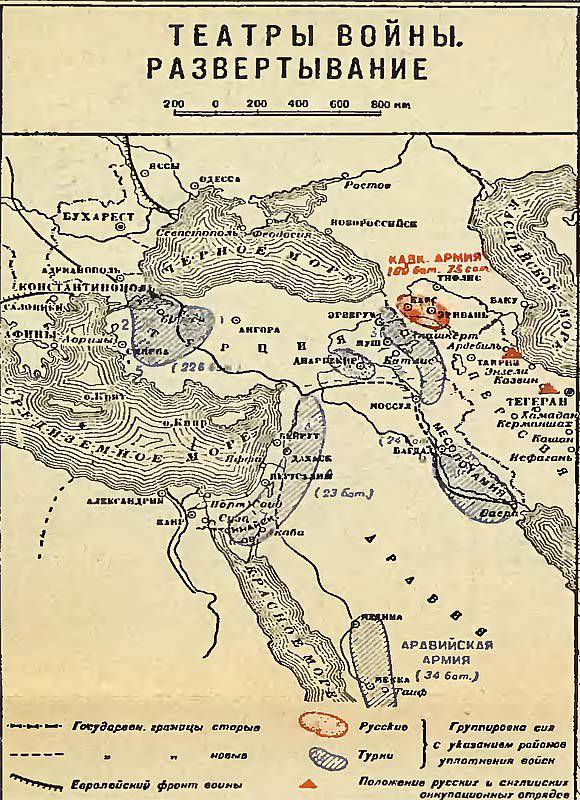
The 3 Army under the command of the Minister of War and Commander Enver Pasha (commanded by Gassan Izzet Pasha at the first stage) was the strongest in the 190 battalions (the 537 battalions were deployed at the beginning of the war). The army was strengthened by German personnel. The chief of staff was the German General F. Bronzart von Shellendorf, the chief of the operations department, Major Feldman. Part of the force was deployed against Persia, so directly around 180 bayonets and sabers were directly against Russia. With irregular Kurdish units, the number of troops was much higher.
Despite the active participation of German military advisers in the reorganization of the Turkish armed forces, the mobilization of the 3rd Army in Western Armenia was very difficult. Serious deficiencies in artillery, food and sanitary supplies were noted. Under the rule of the Russian Black Sea fleet at sea, only land communications, which were in an extremely undeveloped and poor condition, had to be used. The 3rd Army consisted of three corps: 9th (17th, 28th and 29th Infantry Divisions), 10th (30th, 31st and 32nd Divisions) and 11th (18th, 33rd and 34th divisions) army corps, 2nd cavalry division, 4 1/2 Kurdish divisions and 2 infantry divisions, which were supposed to arrive from Mesopotamia. Each division had three infantry regiments, an artillery regiment, a sapper company, a cavalry squadron, and one reserve depot. The regiments consisted of three battalions and a machine gun company (4 machine guns). The artillery regiments in their composition had 2-3 field or mountain divisions of 2-3 four-gun batteries (up to 24 guns).
Thanks to the Europeans, the armament of the Turkish infantry was good, but it was not enough for all the troops. Good weapon it was the troops of the first stage, the new formations were already content with what was left. There was almost no modern heavy artillery. Kurdish connections had poor training. Communication, due to lack of supply, was mainly through messengers. The Turkish command did not know the battle area well, having bad maps, with large errors. Turkish soldiers differed discipline, unpretentiousness, in normal conditions showed courage and resilience, especially in defense. But, with the officer corps there was trouble. The military education system, despite the efforts of the Germans, was weak and could not cope with the saturation of the troops with well-trained personnel. At the low level was the thieving quartermaster part. Turkish officials, including the military, generally beaten records of embezzlement. The soldiers had to live on the pasture, the fact that he could give the basing area. They ate mostly rice, boiled corn, black bread and beans.
At the first stage, the Ottomans wanted to complete the concentration of troops, limiting themselves to defense. Then the German-Turkish command planned to strike at Kars from the Erzurum area, crush the Russian border units and advance on Erivan. On the flanks were going to deliver auxiliary blows. On the left, seaside flank, they set the task of striking at Batum and Ardahan, followed by a breakthrough at Tiflis. On the right flank - through Persian Azerbaijan to Nakhichevan and Baku. The Turks hoped that they would be supported by local Muslims.
In Russia, with the beginning of the war, the Caucasian Army was formed from the Caucasus region. The Caucasian governor, Illarion Ivanovich Vorontsov-Dashkov, became its commander-in-chief. It was an old and experienced statesman who had participated in the Caucasian War in his youth. Vorontsov-Dashkov was a true statesman, and did a lot for the development of the Caucasus. However, he was an old, sick and tired man (he died in 1916), so Vorontsov-Dashkov practically did not take part in the development of operations and command of the troops, transferring command of the army to General Alexander Zakharyevich Myshlayevsky, after his removal to General Nikolai Nikolayevich Yudenich.
Myshlaevsky was a theorist, not a practitioner, a teacher at the Academy of the General Staff. But his chief of staff was a real combat general, Nikolai Yudenich. It was not for nothing that he was called the last commander of the Suvorov school (One of the best generals of Russia during the First World War, Nikolai Nikolayevich Yudenich). Yudenich I became famous Russian-Japanese war. Noted in the battle of Sandepu, where he personally led the troops began to retreat in bayonet attack and overturned the enemy. In the battle of Mukden, the 18 th Infantry Regiment, commanded by Nikolai Nikolayevich, withstood the onslaught of two Japanese divisions. Yudenich showed “exemplary”, as it was then noted in the award documents, personal courage and fearlessness. At one of the critical moments, Yudenich personally raised one of the battalions to the counterattack. In battle, he was seriously wounded in the neck. Before the war, he headed the headquarters of the Caucasus region and perfectly studied the local conditions. As a result, thanks to Yudenich on the Caucasian front, Russia won a number of brilliant victories, which by the beginning of the 1917 campaign of the year allowed her to hope to join the empire of Western Armenia, the Bosphorus, Dardanelles and Constantinople. But this was still far away.
By the winter of 1914, the Russian Caucasian army consisted of 153 battalions, 175 hundreds and 350 guns. But a significant part of the army was engaged in guarding the rear, the coast or units were still being formed and were in the process of being transferred. Therefore, there were 114 battalions, 127 hundreds and 304 guns on the front line. The army had two corps of the 1st Caucasian and 2nd Turkestan, and a number of separate brigades. The troops of the Russian Caucasian Army were ordinary formations; they did not have special mining units, with the exception of artillery brigades of 6-8 batteries assigned to infantry divisions, some of which were mountainous. Radio communications existed only between large headquarters. The communication service was not organized, which was reflected in the failures of the initial period of the war. The convoys and rear of the Russian troops were not adapted for action in the mountains. True, in the field aviation, which began to be used for reconnaissance, the Russian army had an advantage. The advantage was also in the cavalry.
The Russian Caucasian army is divided into several operational groups, each of which had its own task. On the Primorsky (Batumi) direction there were separate units of the 66 Infantry Division, the 5 of the Turkestan Rifle and 1 of the Kuban Plastun Brigade, the 25 of the Border Guard Brigade. The group, in turn, was divided into the Rion detachment and garrison of the Mikhailovsky (Batumi) fortress with the Chorokh detachment. She was assigned the task of protecting the coast, defending the fortress and covering the strategic right flank of the Caucasian army.
The main forces were divided into three groups. On the Oltinsky direction was the 20-I infantry division of Lieutenant-General N. M. Istomin. In its reserve was the 26-I brigade of the border guard. Oltinsky detachment covered the left flank of the main Sarakamysh group. He was given the task of covering up the Ardagan direction, advancing from Olta on Erzerum, in order to constrain the enemy forces by combat and to ease the position of the main group.
Sarykamysh operational direction was considered the main. It was covered by the main forces of the Russian army: 1-th Caucasian Army Corps under the command of Lieutenant-General G. E. Berhman (as part of two infantry divisions), 1-I Caucasian Cossack Division, 2-th Turkestan Army Corps of General Slyusarenko (two rifle brigades ). The detachment was tasked with attacking the Passinsky valley in order to defeat the Turkish troops covering the Erzerum fortress from the east.
The right flank of the Sarakamish group was covered by the Kagyzman group. The detachment was supposed to seize the Alashkert Valley and the Kara-Derbent Pass with the aim of separating the Erzurum and Bayazet enemy groups. Further south, another grouping was located: the Erivan, Makinsky and Azerbaijani groups. The group was supposed to prevent the emergence of Ottoman forces in the South Caucasus and in Persian Azerbaijan. The Erivan detachment was tasked with destroying the enemy in the Bayazet plain and advancing on the city of Van, that is, in the rear of the Turkish troops, which were operating against the Azerbaijani detachment. The Makin detachment tied up the Erivan and Azerbaijani detachments and guarded the latter’s messages to Julfa, facilitating the movement of the Erivan detachment. The Azerbaijani detachment was supposed to facilitate the movement of the Erivan detachment to the van.
In addition, the 3-I Caucasian Rifle Brigade was located in Kars, and the Siberian Cossack Brigade (army reserve) was located in Tiflis. Another group defended the border with Persia. The border detachment stood on the Russian-Persian border, the Ardebil and Kazvinsky detachments (both in Persia), maintained order in the area bordering Persia, and guarded the Anzeli and Tehran highways.
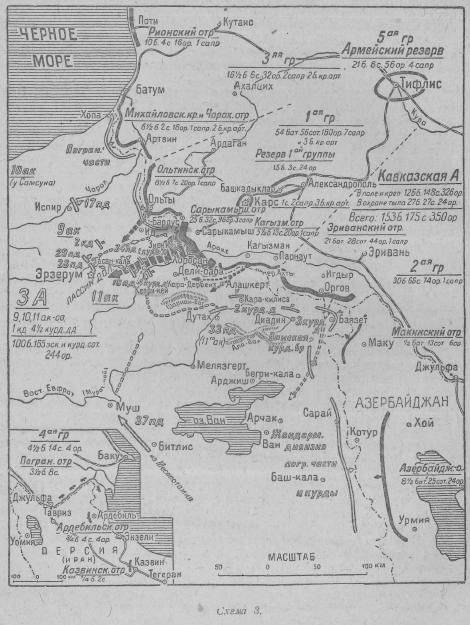
Passive defense in a complex, 720-km front from the Black Sea to Lake Urmia was deliberately disastrous. The Ottoman command received a strategic initiative and the ability to concentrate forces and strike anywhere. Therefore, the Russian commander-in-chief, Grand Duke Nikolai Nikolayevich, taking into account the minor importance of the Caucasian front and difficulties with the deployment of troops, even admitted that the Ottomans would take up the first stage and need to leave Transcaucasia.
With the receipt of the telegraph message, a military council was gathered in Tiflis. Yudenich made a report on the state of the enemy army, its mobilization capabilities. The main Turkish grouping was concentrated at Erzerum. The 10 Army Corps was located in the Samsun area. The Russian command assumed that at the start of the war the 3 of the Turkish army would confine itself to defense. Yudenich noted that the Caucasian theater is secondary, therefore serious reinforcements from the central regions of Russia should not be expected in the near future. It was believed that in the Sarykamysh direction, Russian troops had almost double superiority over the Turkish army. But in the Oltinsky direction, the Istomin detachment was much inferior to the enemy. In addition, the Russian army had an advantage in cavalry, the Turkish regular cavalry and the Kurdish irregular cavalry were much inferior in combat qualities to the Russian cavalry.
Yudenich, on the basis of the general balance of forces and means and the approach of winter, when it is almost impossible to fight in the mountains, suggested at the first stage to limit active defense. It was necessary to complete mobilization, form reserves, prepare reserves and prepare for the 1915 campaign of the year. This decision was supported by other members of the council, including the Caucasian governor Vorontsov-Dashkov. Active defense and reconnaissance in force was entrusted to the vanguards.
The first fights. Capture Bayazeta
Kagyzmansky detachment was commanded by an old, experienced combat general, Dmitri Konstantinovich Abatsiev. He began serving as a simple Cossack and was a personal orderly under General Skobelev. Dmitry Konstantinovich taking part in almost all the battles of the Russian-Turkish war 1877-1878. Abatiev was a Russian of Ossetian origin, and for military distinctions he was three times awarded a soldier’s Cross of St. George. Contemporaries told legends about his courage. After the Balkans, fought in Central Asia. During the storming of Geok-Tepe (in 1881), he was seriously wounded and was awarded the Golden (Georgievsky) weapon. He fought in the Far East in the Russian-Japanese war. Entered the First World War, the commander of the 2-th Caucasian Cossack Division.
1 November 1914, the Erivansky and Makinsky detachments from two directions moved to Bayazet. The basis of the Erivan Detachment was the 2-I Cossack Division, and in the head of the detachment there was the 2-I Plastun Brigade, General Ivan Gulyga. The scouts, the Cossack infantry, were at that time a kind of special units that carried out patrol, reconnaissance and sabotage tasks. They were famous for exceptional endurance, could move almost nonstop, roads, and on the marches happened ahead of the cavalry. They were used as military intelligence, differed excellent possession of small arms and cold arms. At night, they preferred to take the enemy with knives (bayonets), in silence, without warcries and shots, cutting out patrols and small units of the enemy. In battle, they were distinguished by cold fury (a kind of fighting trance, the ancient Russian military tradition) and calm, which inspired terror to the enemy. Because of the constant marches and creeps (hence the "scouts"), the Cossacks often looked like rags, which was their privilege. In addition, the plasmons retained the spirit of the ancient Russian army, with its fraternity and a certain liberty. They discussed the most important questions in a circle.
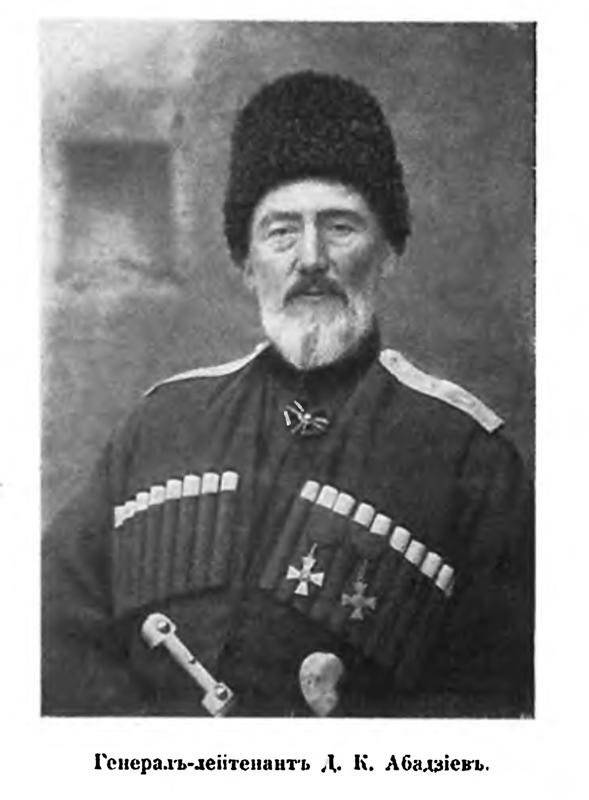
The commander of the 2 Caucasian Cossack Division Dmitry K. Abatsiev
The Turkish command knew that in this direction Russian troops did not have much and did not expect such a rapid invasion. Turkish regular units focused on rear lines. Only forward barriers and Kurdish militia entered the battle. First, the Russian Cossacks tried to stop at Chingilsky Pass. Russian troops pulled guns, shot down the enemy and occupied the pass. On Mysunsky pass the defense of the enemy was stronger. Two Turkish battalions entrenched here. The scouts attacked the enemy from the front, from the flank hit the Turks 1 th Labinsky Cossack regiment. Turks crushed, 200 people chopped up, the rest surrendered or fled. The road to Bayazet was open.
The Makin detachment included the Transcaspian Cossack Brigade under the command of Andrei Nikolayev from the 2 of the Turkestan Army Corps. The Kurds set up an ambush in which hundreds of 1 Taman regiments fell. They were good shooters, and many Cossacks fell. Nikolaev, bypassing the enemy position, sent two hundred 1 Caucasian regiment. Kurds were bypassed and when they ran, they were chopped up.
On November 4, the advance units of the Abaciyev and Nikolayev detachments reached Bayazet. It was a serious fortress that played a strategic role in past wars. However, the Turks did not have time to arrange a large garrison here. Seeing that approaching Russian troops, the Ottoman garrison threw the fortress and fled. As a result, Bayazet was taken without a fight. It was a great success. Then the 2-I Caucasian Cossack Division and the Transcaspian Brigade merged and moved west into the Dyadinsky Valley. Russian combined 7-th. a detachment in two battles swept Kurdish and Turkish barriers, and took the city of Jiadin. Many prisoners were captured, warehouses with weapons and ammunition.
Keprikeyskoe battle
In the Erzurum direction, the troops of General George Berhman, dispersing enemy barriers, advanced along the Passinskaya valley. On the right flank, the Istomin detachment reached the Ottoman positions near the city of Ardap. The Turks could not stand the night attack and fled in panic. On the left bank of the Araks, the 1-I Caucasian Cossack Division of Nikolai Baratov captured the important Keprikei bridge. The 1-I Kuban Plastun Brigade of General Mikhail Przhevalsky (cousin of the Russian traveler General N. M. Przhevalsky) overcame the ridge of Agridag and stormed the city of Akhty. The Kazks descended from the Alashkert Valley and took Alashkert with a surprise night attack.
Meanwhile, the 1 Caucasian Corps of Berchman reached the first strong line of the Turkish defense, which was held on the dominant heights near the town of Keprikei (Kepri-Kei). However, there were few Turkish troops on the fortified line, so on November 7, Russian troops seized them on the move. It seemed that the way to Erzurum was open. However, the commander of the 3 of the Turkish army sent troops of the 9 and 11 of the army corps to meet the Russian troops. At this time in the Caucasus began an early mountain winter, it became cold, snow fell.
On November 8, the superior forces of the Ottomans emerged from the blizzard and, knocking over our warheads, piled on the main forces of the Russian corps. Both sides are bogged down in a fierce battle. A fresh Turkish division appeared on the northern flank and began to bypass the Berchman corps. The general transferred troops from other directions to the dangerous area, the Turkish attack was repulsed. But the Turkish troops had a significant advantage and violently attacked. Reflecting the enemy onslaught by counterattacks, the Russian troops slowly retreated and on November 11 left Keprikei. Turkish troops continued the offensive, bypassing the Russian right flank and made their way to the Russian border. Turkish troops were advancing from the south along the valley of the Araks. At the same time, the Turks pulled the 10 corps as a reserve to Erzerum from Anatolia.
Keprikeyskoe battle
On the other direction, the troops of Abaciyev continued their successful offensive. The Cossacks occupied the Bayazet and Dyadinsky valleys with a quick strike, entered the Alashkert, where they joined with the Przhevalsky plasters. Following the cavalry, the infantry of the 66 division advanced, which was fixed on the occupied lines. Abatsiv sent separate detachments, which fought took the passes of Klych-Gyaduk and Taparizsky. The Turkish army blocked the direction for strikes from the south. 1 th Plastun brigade Przewalski changed, it was transferred to the main direction.
The scouts made the hardest forced march from Alashkert back across the mountains to Kagyzman. From there, the brigade moved to a breakthrough on the left flank of Berhman, on the Araks. On November 15, plasters smashed and forced the 33 Turkish Infantry Division to retreat. On the night of November 17, Pržvavalsky decided to force the Araks and make a night raid on Turkish positions. By giving an example, the brigade commander first entered the icy water. The scouts suddenly appeared in the Turkish rear and hit with knives and bayonets. Having arranged a terrible panic, the plasters ... disappeared. Forced the river and returned to their positions.
Meanwhile, parts of the 2 Turkestan Corps began to arrive at the front. They counterattacked the enemy on the right flank, eliminated the threat of a breakthrough from Karaurgan. As a result, the Turkish onslaught exhaled, the front stabilized until the 1915 campaign of the year. Both sides began to prepare the troops for the winter. In the Battle of Keprikei, the Turkish army lost 15 thousand people killed, wounded and captured, Russian troops 6 thousand people killed and wounded (the Ottomans did not take prisoners).
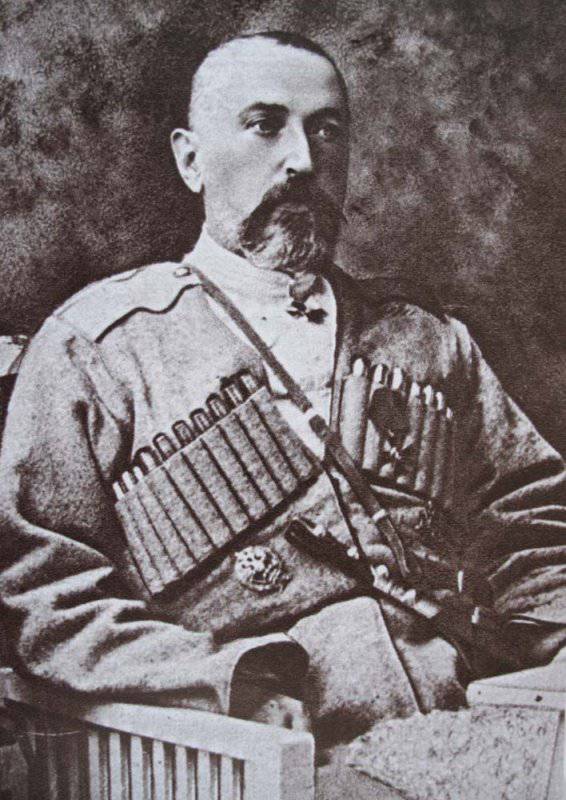
Commander of the Kuban Plastun Brigade, Mikhail Alekseevich Przhevalsky
Persian direction
In the Persian direction, Russia was forced to send troops to Persia. By 1914, Persia, in the past a great regional power, having fought Turkey for leadership in the region for centuries, experienced a period of decline, turned into a semi-colony of European powers. However, it had an important strategic position between India, the Persian Gulf, the Caucasus, Mesopotamia and Anatolia. In addition, the country had large reserves of oil. The strategic plans of Berlin in Persia were to try to cut off the Entente countries from Iranian and Azerbaijani oil and create a united front of Muslim countries against them. With the help of Porta, which declared the powers of the Entente Jihad, Germany planned to win over the Muslim countries of Central Asia - Persia, Afghanistan, the north-western part of British India (the Muslim part), and also Egypt. For this purpose, the Eastern Intelligence Bureau was formed in Constantinople. In Persia, they wanted to organize a big uprising against the Russians and the British (England and Russia in the pre-war period divided Persia into spheres of influence).
Persia at the beginning of the war declared neutrality. But Turkish emissaries were active in Iran. They aroused anti-Russian sentiments, incited local tribes against Russia. Istanbul and Berlin together put pressure on the Shah’s government, demanding to act against the Russian Empire. They threatened that they would be forced to violate Iranian neutrality. Turkish frontier and gendarme units and Kurdish troops began to enter the western regions of Persia. As a result, Russia was forced into Persia by the Azerbaijani detachment of General Chernozubov as part of the 4 Caucasian Cossack Division and the 2 Caucasian Rifle Brigade with 24 guns. The appearance of Russian troops forced the tribes ready to rebel. Russian troops deployed along the Turkish-Iranian border, defeated and drove out the Turkish-Kurdish forces. Russian troops themselves began to threaten Turkey from the south-east. The cities of Saray, Bash-kale were occupied. However, for the development of the first success of the troops was not enough.
Results
Thus, the start of the war in the Black Sea and the Caucasus did not meet the expectations of Istanbul. The Black Sea Fleet retained full combat effectiveness and almost immediately began to respond with raids along the shores of Turkey. On November 2, the Black Sea Fleet almost went on full march to disrupt enemy communications. Russian battleships struck at Trebizond. Minelayers laid mines off the Turkish coast. The German admiral Souchon attempted to intercept the Russian ships and, if possible, destroy the squadron in parts. The meeting took place 5 (18) in November southwest of Yalta at Cape Sarych (Black Sea Fleet during the First World War. Part of 2). The battle of the old battleship "Evstafy" (the other battleships, for various reasons, could not get at the enemy) and "Goeben" ended in favor of the Russians. The first two-gun salvo of the flagship battleship Evstafy covered the enemy cruiser. The Germans rushed to retire. "Goeben" received 14 hits, lost about 170 people killed and wounded. After that, the German cruiser in direct battle with the Russian battleships tried not to enter.
On the Caucasian front, the situation was stable. On the main Erzurum direction, the Turkish army was able to repel the offensive of the Sarykamysh detachment of General Berhman. This inspired the German-Turkish command and gave them the determination to launch a new offensive operation in the same year (the Sarykamysh battle). On the flanks, Russian troops were victorious up. In the Oltinsky direction, the Russian detachment of General Istomin reached the line Ardos and Eid. On the Erivan direction, the Russian troops took Bayazet and, on a broad front, reached the mountain line south of the Agri-Dag ridge. The threat in Persia was eliminated.
Inside the Ottoman Empire, the situation was difficult. The country's entry into the war only worsened the situation. Agriculture, due to the separation of hundreds of thousands of young men from production, was in crisis. The crisis has affected most of the industries. The state apparatus was overwhelmed by a new wave of corruption and theft. Officials lived on the principle “after us even the flood”. Opposition arose, so n. The “Old Turks” who accused the Ittihadists of having departed from Islamic traditions, got bogged down in political adventures and laid down under the Germans. The Young Turks were accused of “holy war” with “infidels” under the direction of other “infidels”. Such moods were skillfully supported by Britain. Under the wing of the British "Knights of the Cloak and Dagger", a council of senior ulamas gathered in Egypt, deciding that Turkey’s actions were in sharp contradiction with the main interests of Islam. In addition, the British skillfully began to use the national contradictions in the Ottoman Empire. They began to play the game with the Arab tribes, intending to split the Arabian Peninsula and Iraq from the Ottoman Empire. Empire accelerated to the bottom.
Group of battleships of the Russian Black Sea Fleet. The first is Eustathius.
Sources:
Kersnovsky A.A. History Russian army // http://militera.lib.ru/h/kersnovsky1/index.html.
A. Kolenkovsky. The Maneuvering Period of the First World Imperialist War 1914, M., 1940 // http://militera.lib.ru/h/kolenkovsky_ak2/index.html.
Korsun N. Campania 1914 on the Caucasian Front. Military history magazine №5 for 1940 year // http://www.retropressa.ru/kampaniya-1914-g-na-kavkazskom-fronte/.
Korsun N. G. The First World War on the Caucasian Front. Operational and strategic essay. M .: 1946 // http://militera.lib.ru/h/korsun_ng05/index.html.
Sarykamysh battle // http://topwar.ru/34212-sarykamyshskaya-bitva.html.
"Only he is worthy of this life, who is always ready to die." One of the best generals of Russia during the First World War, Nikolai Nikolayevich Yudenich // http://topwar.ru/34157-tolko-tot-dostoin-zhizni-etoy-kto-na-smert-vsegda-gotov-odin-iz-luchshih- generalov-rossii-perioda-pervoy-mirovoy-voyny-nikolay-nikolaevich-yudenich.html.
The Black Sea Fleet during the First World War // http://topwar.ru/2795-chernomorskij-flot-v-gody-pervoj-mirovoj-vojny.html.
Black Sea Fleet during the First World War. Part of 2 // http://topwar.ru/2836-chernomorskij-flot-v-gody-pervoj-mirovoj-vojny-chast-2.html.
Shishov A.V. Yudenich: General of the Suvorov School. M., 2004.
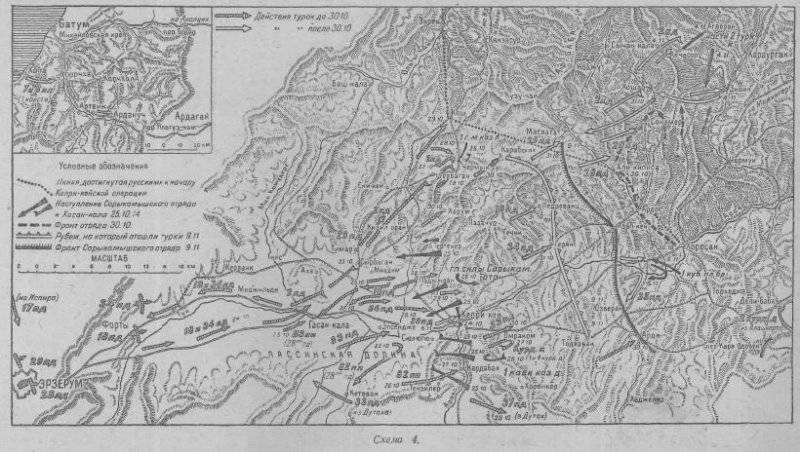
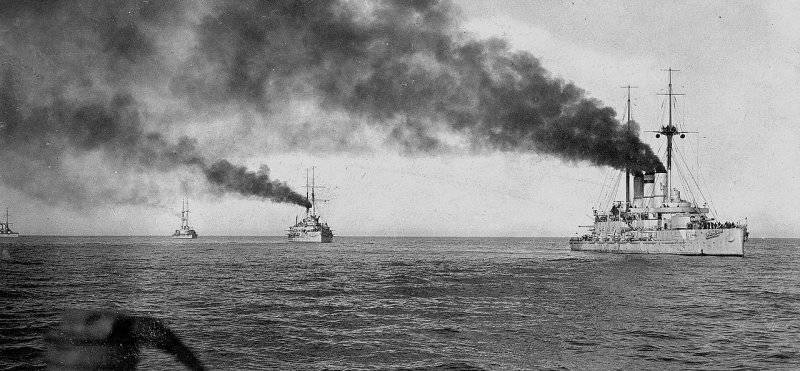
Information